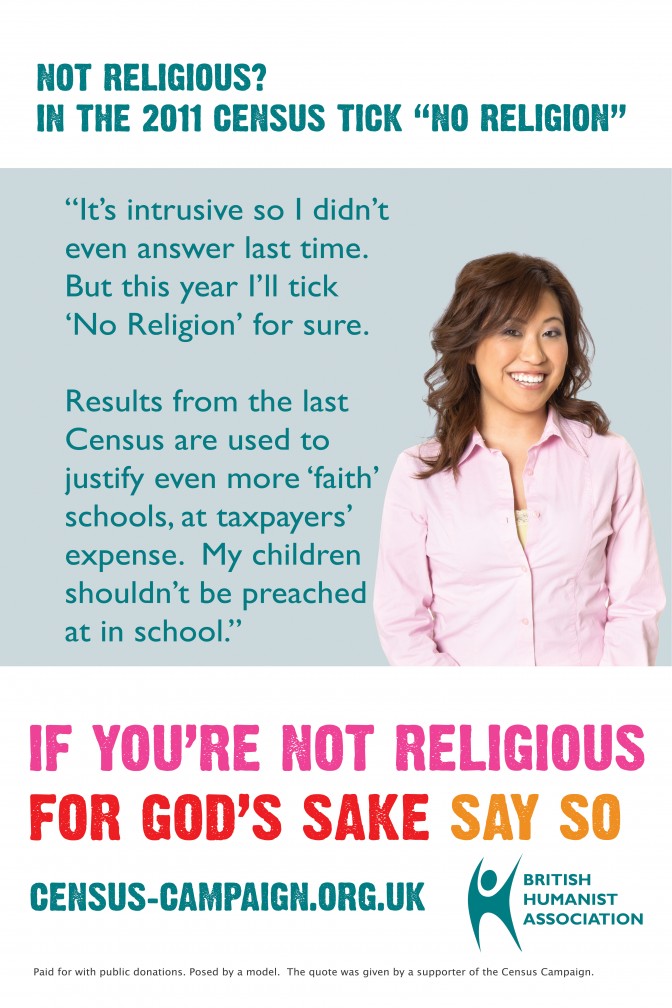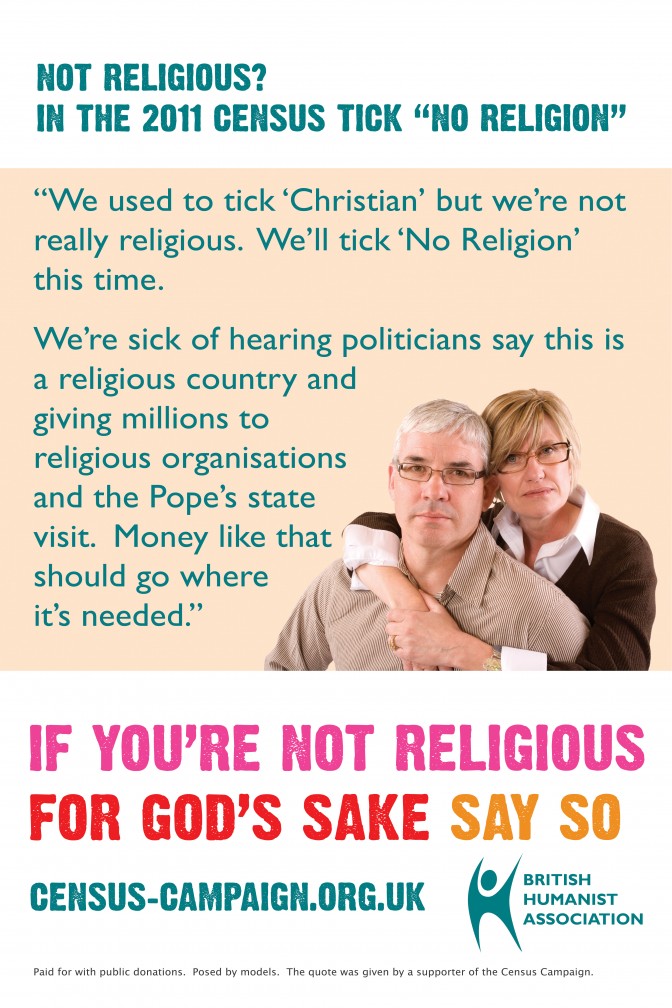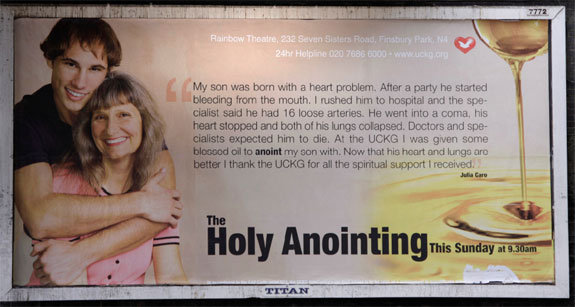We are concerned that the Advertising Standards Authority (ASA) and its sister organisation the Committee of Advertising Practice (CAP), who de facto regulate access to advertising space, are far too censorious in deeming certain adverts to be religiously ‘offensive’, even when the vast majority of observers would say they are not, and therefore disallowing them from appearing.
We believe that such subjective tests of ‘offence’ should not appear in the advertising codes of practice that the ASA and CAP maintain, and have long spoken out against examples of censorship that amount to the reintroduction of the blasphemy law, for advertising, by the back door.
We also believe that advertisers have a public responsibility to be truthful. Demonstrably untrue or misleading claims should not be allowed to appear in adverts, even when religiously motivated, and believe the ASA has been better over the years in its approach to such adverts.
In depth
The ASA and CAP maintain two codes of practice: the Advertising Code and the Broadcast Advertising Code. If a member of the public believes an advert contravenes one of the codes then they may object to the ASA about this advert, who will then determine whether or not the advert meets the requirements of the code and issue a ruling on whether or not the advert can appear again. The ASA and CAP consider themselves to be public bodies, as their decisions are enforced because the owners of advertising spaces invariably refuse to show adverts that the ASA has ruled against.
‘Offence’
Rule 4.1 of the Advertising Code says, ‘Marketing communications must not contain anything that is likely to cause serious or widespread offence. Particular care must be taken to avoid causing offence on the grounds of race, religion, gender, sexual orientation, disability or age.’
Similarly, section 4 of the Broadcasting Code opens by saying, ‘Advertisements must not be harmful or offensive. Advertisements must take account of generally accepted standards to minimise the risk of causing harm or serious or widespread offence.’ It goes on to say in rule 4.2 that ‘Advertisements must not cause serious or widespread offence against generally accepted moral, social or cultural standards.’ Freedom of expression is not mentioned in these relevant sections at all.
Examples of banned ads
These sections have repeatedly been used to ban adverts that, at best, we think are mildly offensive to some, and at worst cannot really be said to be offensive at all. To provide some examples:
- In 2023, the ASA found that a poster promoting Demi Lovato’s album was ‘likely to cause offence to Christians‘. The poster had been displayed at only six locations across London in the summer of 2022 before being taken down four days later. It depicted the clearly recognisable singer ‘in a bondage-style outfit whilst lying on a large, cushioned crucifix’, along with the name of the album, ‘HOLY FVCK’. Complaints were made to the ASA about the poster on two grounds – that the advertisement would cause ‘serious or widespread offence’ and that it was ‘irresponsibly placed where children could see it.’ Both grounds were upheld by the ASA. While the poster could have reasonably been banned solely for containing language that was easily recognisable as alluding to a swear word, and for its inappropriateness for children, Humanists UK criticises the ASA also banning the image for being religiously offensive.

- In 2016, the ASA deemed offensive under rule 4.1 a Boylesports Gaming advert about a gambling promotion, that ran during Easter and featured a hand nailed to a cross. The ASA wrote, ‘we considered that the way in which the ad made light of the subject matter, with the play on words “NAILED ON BONUS”; the jokey language of “BETWEEN 5-25 QUID”, “dearly departed JC” and “sacrilecious Bonus”, and the cartoon-style image of blood dripping from the hand pierced by the nail, a particularly sacred image for Christians, were likely to cause serious offence to some recipients. We considered the offence was likely to be particularly strongly felt by those of the Christian faith at Easter, when the imagery would have a particularly strong resonance.’ No consideration was made of the graphic depiction of violence in the ad.

- In 2014, the ASA deemed offensive under rule 4.1 a Sporting Index advert about placing bets during that summer’s World Cup in Brazil. The ad featured a picture of Christ the Redeemer and a bikini-clad woman, encouraging ‘£500 in free bets’ and with the tagline ‘There’s a more exciting side to Brazil’. The ad broke rules linking gambling to sex, but it also broke religious offence rules because, ‘despite this secular use [of the statue], it was still a depiction of Jesus and was likely to carry a large degree of religious significance for Christians in particular’, and ‘we considered that a depiction of Jesus with his arm around a largely undressed woman, holding a champagne bottle and apparently celebrating a gambling win was likely to cause offence to a significant number of Christians, regardless of this humorous intention or references to Rio de Janeiro and the World Cup, because it depicted the person of Jesus in a context at odds with commonly held beliefs about the nature of Christ.’

- In 2011, the ASA deemed offensive under rule 4.1 a Phones 4 U advert that featured a drawing of the Buddy Christ from the movie Dogma saying ‘Miraculous deals on Samsung Galaxy Android phones’. They reached this view because ‘We considered that, although the ads were intended to be light-hearted and humorous, their depiction of Jesus winking and holding a thumbs-up sign, with the text “Miraculous” deals during Easter, the Christian Holy Week which celebrated Christ’s resurrection, gave the impression that they were mocking and belittling core Christian beliefs. We agreed that the ads were disrespectful to the Christian faith and were likely to cause serious offence, particularly to Christians.’




- In rulings in 2009-2010, the ASA banned three adverts under rule 4.1 by ice cream company Antonio Federici that depicted, respectively, a priest and a nun about to kiss; two priests about to kiss; and a pregnant nun. The ads were deemed to be ‘mocking the beliefs of Roman Catholics and was therefore likely to cause serious offence to some readers.’

- In 2008, ghd hair straightener adverts were deemed offensive under the broadcasting code for using the tagline ‘thy will be done’ while juxtaposing pictures of women.
We have an example of our own: in 2011, in the run-up to the 2011 Census, we proposed to run three adverts (below) in railway stations encouraging people to tick ‘no religion’ on the form. However, the owners of the advertising space submitted the ads to the Committee on Advertising Practice prior to their running to see whether or not they might be offensive. The Committee replied that were the ads to run and then be subject to an ASA adjudication, in their view it was likely that the ASA would deem the phrase ‘For God’s Sake’ as offensive under paragraph 4.1 of the Code.
As a consequence, the company controlling the advertising space at the railway stations immediately refused to even carry the ads.



The ASA is not the only body to use subjective ‘offence’ tests in deciding which adverts to run. Paragraph 3.1 of Transport for London’s advertising policy that states that ‘Advertisements will not be approved for, or permitted to remain on TfL’s services, if, in TfL’s reasonable opinion, the advertisement falls within any of the following categories: … (d) The advertisement is likely to cause widespread or serious offence to members of the public on account of the nature of the product or service being advertised, the wording or design of the advertisement or by way of inference… (k) The advertisement contains images or messages which relate to matters of public controversy and sensitivity.’
In 2013 a High Court judge ruled, and in 2014 a Court of Appeal judge agreed, that adverts by Stonewall and Humanists UK – saying, respectively, ‘Some people are gay. Get over it!’ and ‘There’s probably no God. Now stop worrying and enjoy your life’ – broke this policy, and so if TfL had been implementing the policy correctly, the adverts should not have been allowed to run. The rulings in question have had no practical impact on these two ads, as they were incidental to the main thrust of the case. But it is particularly alarming, given that both adverts were subject to ASA complaints but deemed by the ASA to be Code-compliant.


We do not believe that ads should be banned by the ASA, CAP, or public authorities merely for being ‘offensive’ as we think this leads to subjective judgments and risks stifling free speech. This seems to us to reinstate the blasphemy law that parliament repealed in 2008.
Factual claims

Contrary to the above, one place where we believe the ASA and CAP has been better in its decisions is in disallowing adverts that make demonstrably false claims. This includes claims about the supposed efficacy of homeopathy but also religious claims that at their most extreme can be seriously dangerous to people’s health. For example in 2009 the ASA ruled against the Universal Church of the Kingdom of God, following a Humanists UK complaint against a billboard claiming holy ointment cured a child’s otherwise-fatal heart and lung conditions.
In 2012, the ASA ruled that Healing on the Streets should not be able to claim, in its leaflets or online, that ‘God can heal… Back Pain, Arthritis, MS, Addiction … Ulcers, Depression, Allergies, Fibromyalgia, Asthma, Paralysis, Crippling Disease, Phobias, Sleeping disorders or any other sickness’. Disappointingly however it later decided that the group’s website was outside its remit.
What we’re doing
- In 2019, we launched a petition calling for the removal of the rules surrounding offensive content in response to the review of these rules by CAP, which proposed to bring the rules in line with the requirements of the Equality Act.
- In 2019, we submitted a response to CAP’s consultation on public sector equality duty, urging it to take seriously any cases of discrimination but that religion and belief must still be subject to scrutiny and criticism, even if it causes offence.
- In 2016 we responded to an Equality and Human Rights Commission (EHRC) consultation about religion and belief advertising to speak out against these past decisions.
- We have consistently spoken out against the ASA’s censorious decisions where it has deemed adverts to be ‘offensive’ even when this hardly seems to be the case. We have met and extensively corresponded with CAP officials to try and secure a change to the Codes, as well as responding to consultations on revisions to them, but have so far been unsuccessful.
Get involved
You can support Humanists UK by becoming a member. That helps in itself, and you can help even more by supporting our campaigns in the ways suggested above. But campaigns also cost money – quite a lot of money – and we also need financial support. You can make a donation to Humanists UK.
